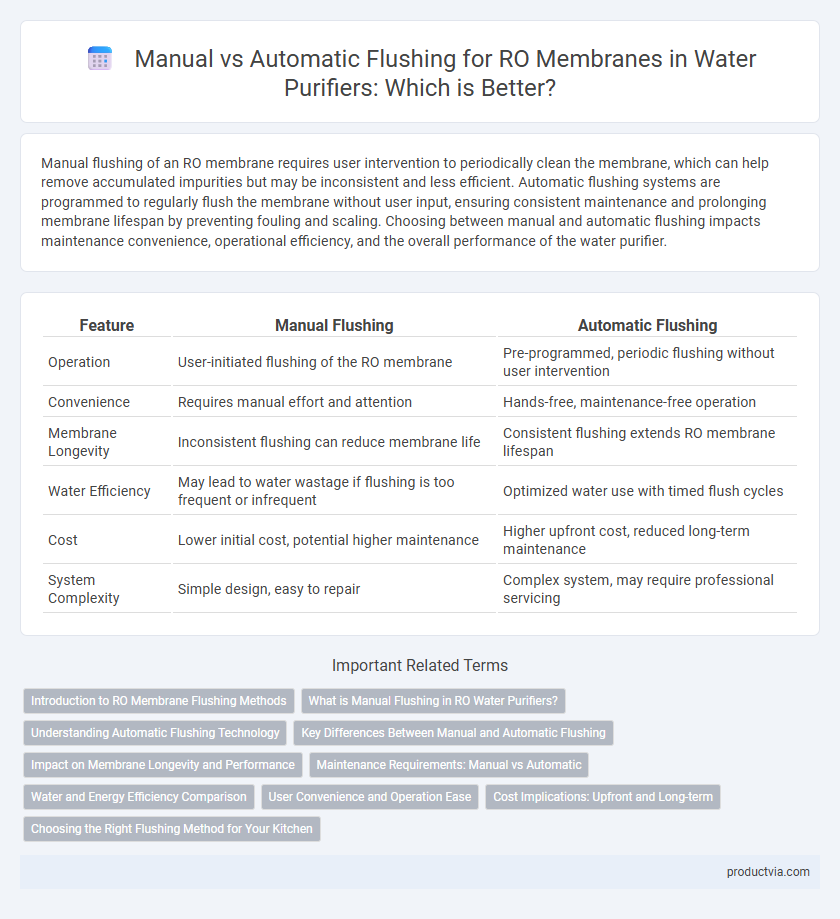Manual flushing of an RO membrane requires user intervention to periodically clean the membrane, which can help remove accumulated impurities but may be inconsistent and less efficient. Automatic flushing systems are programmed to regularly flush the membrane without user input, ensuring consistent maintenance and prolonging membrane lifespan by preventing fouling and scaling. Choosing between manual and automatic flushing impacts maintenance convenience, operational efficiency, and the overall performance of the water purifier.
Table of Comparison
| Feature | Manual Flushing | Automatic Flushing |
|---|---|---|
| Operation | User-initiated flushing of the RO membrane | Pre-programmed, periodic flushing without user intervention |
| Convenience | Requires manual effort and attention | Hands-free, maintenance-free operation |
| Membrane Longevity | Inconsistent flushing can reduce membrane life | Consistent flushing extends RO membrane lifespan |
| Water Efficiency | May lead to water wastage if flushing is too frequent or infrequent | Optimized water use with timed flush cycles |
| Cost | Lower initial cost, potential higher maintenance | Higher upfront cost, reduced long-term maintenance |
| System Complexity | Simple design, easy to repair | Complex system, may require professional servicing |
Introduction to RO Membrane Flushing Methods
RO membrane flushing methods include manual and automatic flushing, both essential for maintaining optimal performance and extending membrane lifespan. Manual flushing requires user intervention to remove accumulated contaminants and biofilm, while automatic flushing utilizes timed or sensor-based systems for regular cleaning without manual effort. Effective flushing prevents fouling and scaling, ensuring consistent water flow and high-quality purification in reverse osmosis systems.
What is Manual Flushing in RO Water Purifiers?
Manual flushing in RO water purifiers refers to the process where users initiate the cleaning of the RO membrane by manually activating a flush valve or button. This method helps remove accumulated impurities and contaminants from the membrane surface, maintaining filtration efficiency and prolonging membrane life. Manual flushing requires user intervention and periodic attention to ensure the membrane remains clean and operational.
Understanding Automatic Flushing Technology
Automatic flushing technology in RO membranes enhances system efficiency by periodically removing accumulated impurities without user intervention. This process extends membrane lifespan and maintains optimal filtration performance by preventing fouling and scaling. Compared to manual flushing, automatic flushing ensures consistent cleaning cycles, reducing maintenance efforts and improving water quality.
Key Differences Between Manual and Automatic Flushing
Manual flushing of RO membranes requires user intervention to initiate the cleaning process, which helps remove accumulated contaminants but may lead to inconsistent maintenance if neglected. Automatic flushing systems activate at programmed intervals or based on sensor feedback, ensuring regular debris removal and prolonging membrane lifespan with minimal user effort. Key differences lie in convenience, consistency, and the potential for improved membrane performance through automated flushing technology.
Impact on Membrane Longevity and Performance
Manual flushing of RO membranes requires user intervention and can lead to inconsistent cleaning, potentially reducing membrane lifespan due to accumulated contaminants. Automatic flushing systems ensure regular, controlled rinsing cycles that prevent scaling and fouling, significantly enhancing membrane durability and maintaining optimal performance. Consistent flushing in automatic systems reduces downtime and sustains higher water quality by preserving membrane integrity over time.
Maintenance Requirements: Manual vs Automatic
Manual flushing of RO membranes requires regular user intervention to initiate cleaning, increasing maintenance effort and the risk of inconsistent membrane performance. Automatic flushing systems optimize maintenance by programmatically removing contaminants, reducing downtime and prolonging membrane life through consistent and thorough cleaning cycles. Choosing automatic flushing minimizes manual labor and enhances long-term reliability of water purifiers by maintaining optimal membrane functionality.
Water and Energy Efficiency Comparison
Manual flushing of RO membranes requires user intervention and typically consumes more water and energy due to inconsistent cleaning intervals, leading to decreased membrane lifespan. Automatic flushing systems use sensors and programmed cycles to optimize water usage, significantly reducing wastage and enhancing energy efficiency by maintaining membrane performance. Studies show automatic flushing can reduce water consumption by up to 30% and energy use by around 20% compared to manual methods.
User Convenience and Operation Ease
Manual flushing for RO membranes requires users to actively initiate the cleaning process, which can be time-consuming and may lead to inconsistent maintenance if neglected. Automatic flushing systems enhance user convenience by periodically and effortlessly clearing the membrane without manual intervention, ensuring consistent performance and prolonging membrane life. This operation ease reduces maintenance efforts and minimizes downtime, making automatic flushing a preferred choice for efficient and hassle-free water purification.
Cost Implications: Upfront and Long-term
Manual flushing of RO membranes typically involves lower upfront costs due to simpler valve mechanisms but demands regular user intervention, which can increase labor or maintenance expenses over time. Automatic flushing systems, while requiring higher initial investment for advanced sensors and control units, reduce the risk of membrane fouling and extend membrane lifespan, leading to lower long-term replacement and operational costs. Evaluating both options requires balancing immediate budget constraints with projected maintenance savings and system efficiency gains.
Choosing the Right Flushing Method for Your Kitchen
Choosing the right flushing method for your RO membrane impacts the longevity and efficiency of your water purifier significantly. Manual flushing requires user intervention to clean the membrane, which can be effective but risks inconsistent maintenance and potential buildup of contaminants. Automatic flushing systems offer regular, scheduled cleaning that prevents scale and fouling, ensuring optimal water flow and purification for kitchen use.
Manual vs automatic flushing for RO membrane Infographic

 productvia.com
productvia.com